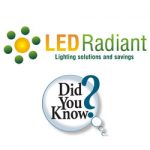KNOW BEFORE SWITCHING!
In our last article of things you must know before switching to LED (you can find it here) we learned about wattage, types of tubes, Bulb and tubes bases or connectors, and lenses. We also started understanding the switching to LED business with the first article of this series: read it here
In this last article of the series, we will learn more concepts to be sure that when it is time to choose our next LED bulbs or fixtures, our decision will be base 100% in knowledge and understanding.
Please remember that these are informal definitions, not academic ones and this is because our goal is for you to quickly understand the ideas and not to make a scientific dissertation about them.
COLOR TEMPERATURE:
This is basically what color we perceive the light to be. It is measured in degrees KELVIN (K). The higher the number the blueish the white tends to be, and, vice versa, the lower the number, the yellowish.
- 6000K: Typical color of fluorescent tubes. Probably you’ll find 6,000K in a hospital and because it has a blueish hue, it is not the most popular one.
- 5000K: is considered Natural, hence the name "natural white". This is the color of the light outdoors, on a sunny day. Seems to be, as an average, the most used.
- 4000K: This is where the color starts tending to yellow, but not quite there yet.
- 3000K and less: Definitelly a yellowish hue. Typical color light of the old incandescent bulbs. Ideal to create warm decorative effects.
 Color temperature: A clear approach
Color temperature: A clear approachA note on color temperature:
Terms like "cool white" or "natural" or "soft white" are nothing but marketing attempts to describe what a manufacturer is trying to sell by making it appealing to you.
This is why their meaning is not consensual and you might find a "Cool white" that is actually 4000K or "Soft whites" that are 5500K. Really important to know before switching to LED!
We have tried to make a classification according with reality and the actual "look" of the color.
Regardless, and to avoid confusion, ALWAYS buy by degrees Kelvin which is a standardized measurement and cannot be 2 different ones, independently from the vendor.
IP:
Another must know before switching to LED is the IP. It measures the level of intrusion that a product can stand. IP stands for ingress protection or intrusion protection and this number is especially relevant when it comes to determine whether the product will be installed outdoors or indoors.
The first digit refer to solids and the second to water: generally, in LEDs, you will find: IP40, IP64, IP65 or IP67. Take a look at the graphic to see the meaning of each number.
 IP Rating and its significance
IP Rating and its significanceFeel free to navigate our website searching by this important attribute, IP40, IP64 or others
LUMENS:
Basically is the amount of light emanating out of the bulb or fixture.
The higher the number, the more light you get. Even though it seems that this is a good measurement to compare technologies, it is a tricky one:
KNOW before switching! Fluorescent tubes and HID lamps manufacturers use as "lumen output" the “initial lumen” which is a different measurement than the average, used in LED, hence a lot of confusion comes from comparing with lumens.
Most of the times is better to stay away from comparing lumens.
Now you know a little bit about the all the necessary concepts you must know before switching to LED.
You also probably noticed that, consequently, all our product’s pictures have ALL the information you need to know to make a quick an effective buying decision, much as it is explained in the following picture.
 LEDRadiant comprehensive images
LEDRadiant comprehensive imagesWe truly hope this series of articles were helpful for you and, furthermore, will help reduce researching time and will ease your transition to LED lighting.
If you read our 3 postings, you are ready! Yo have the knowledge to go and make the best decision about your needs. of, course, since we are here to help, please do not hesitate contacting us for more information or to show you different economical options for your next LED switch.
Have a wonderful and illuminated week!
















